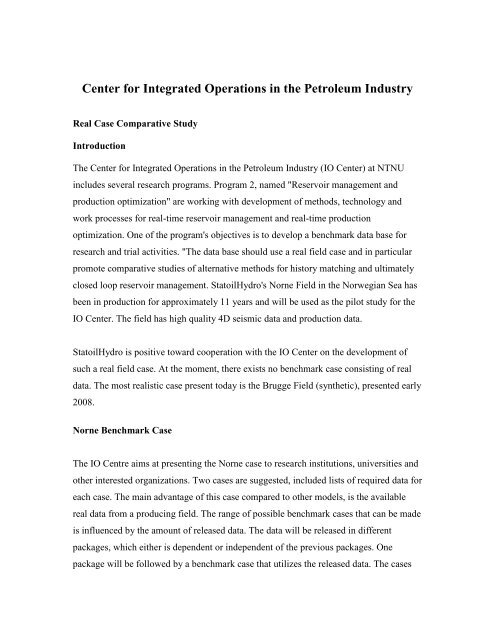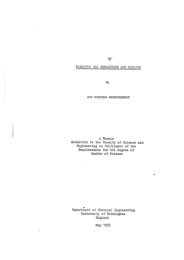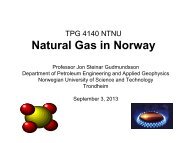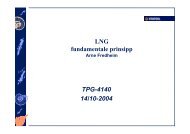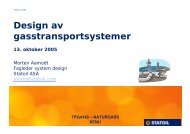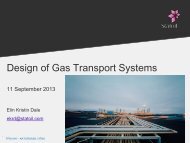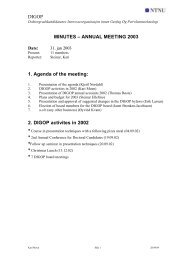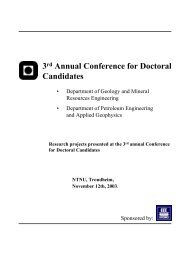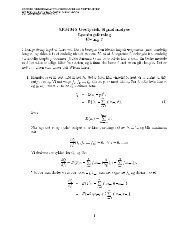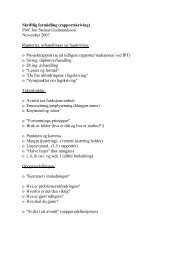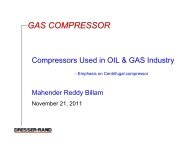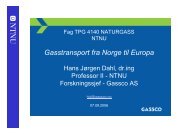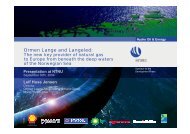Center for Integrated Operations in the Petroleum Industry - NTNU
Center for Integrated Operations in the Petroleum Industry - NTNU
Center for Integrated Operations in the Petroleum Industry - NTNU
You also want an ePaper? Increase the reach of your titles
YUMPU automatically turns print PDFs into web optimized ePapers that Google loves.
<strong>Center</strong> <strong>for</strong> <strong>Integrated</strong> <strong>Operations</strong> <strong>in</strong> <strong>the</strong> <strong>Petroleum</strong> <strong>Industry</strong><br />
Real Case Comparative Study<br />
Introduction<br />
The <strong>Center</strong> <strong>for</strong> <strong>Integrated</strong> <strong>Operations</strong> <strong>in</strong> <strong>the</strong> <strong>Petroleum</strong> <strong>Industry</strong> (IO <strong>Center</strong>) at <strong>NTNU</strong><br />
<strong>in</strong>cludes several research programs. Program 2, named "Reservoir management and<br />
production optimization" are work<strong>in</strong>g with development of methods, technology and<br />
work processes <strong>for</strong> real-time reservoir management and real-time production<br />
optimization. One of <strong>the</strong> program's objectives is to develop a benchmark data base <strong>for</strong><br />
research and trial activities. "The data base should use a real field case and <strong>in</strong> particular<br />
promote comparative studies of alternative methods <strong>for</strong> history match<strong>in</strong>g and ultimately<br />
closed loop reservoir management. StatoilHydro's Norne Field <strong>in</strong> <strong>the</strong> Norwegian Sea has<br />
been <strong>in</strong> production <strong>for</strong> approximately 11 years and will be used as <strong>the</strong> pilot study <strong>for</strong> <strong>the</strong><br />
IO <strong>Center</strong>. The field has high quality 4D seismic data and production data.<br />
StatoilHydro is positive toward cooperation with <strong>the</strong> IO <strong>Center</strong> on <strong>the</strong> development of<br />
such a real field case. At <strong>the</strong> moment, <strong>the</strong>re exists no benchmark case consist<strong>in</strong>g of real<br />
data. The most realistic case present today is <strong>the</strong> Brugge Field (syn<strong>the</strong>tic), presented early<br />
2008.<br />
Norne Benchmark Case<br />
The IO Centre aims at present<strong>in</strong>g <strong>the</strong> Norne case to research <strong>in</strong>stitutions, universities and<br />
o<strong>the</strong>r <strong>in</strong>terested organizations. Two cases are suggested, <strong>in</strong>cluded lists of required data <strong>for</strong><br />
each case. The ma<strong>in</strong> advantage of this case compared to o<strong>the</strong>r models, is <strong>the</strong> available<br />
real data from a produc<strong>in</strong>g field. The range of possible benchmark cases that can be made<br />
is <strong>in</strong>fluenced by <strong>the</strong> amount of released data. The data will be released <strong>in</strong> different<br />
packages, which ei<strong>the</strong>r is dependent or <strong>in</strong>dependent of <strong>the</strong> previous packages. One<br />
package will be followed by a benchmark case that utilizes <strong>the</strong> released data. The cases
are <strong>in</strong>dependent or extensions to an exist<strong>in</strong>g case when new data is released. The<br />
follow<strong>in</strong>g data will be released <strong>in</strong>itially as a description of <strong>the</strong> Norne Field:<br />
- Reservoir simulation model <strong>in</strong> Eclipse history matched until December 2003<br />
- Geological report describ<strong>in</strong>g <strong>the</strong> Stratigraphy of <strong>the</strong> field consist<strong>in</strong>g 17 zones and<br />
petrophysics reports from three wells measurements which gives data regard<strong>in</strong>g to<br />
permeability, water saturation, net-to-gross, thickness, porosity, capillary<br />
pressure, porosity-permeability relationship <strong>in</strong> all <strong>for</strong>mations.<br />
- All wells <strong>in</strong>clud<strong>in</strong>g well logs.<br />
- The reservoir has been produc<strong>in</strong>g from 1997, oil rate, water rate, gas rate are<br />
available <strong>for</strong> each well and FBHP are also recorded, <strong>the</strong> model is history matched<br />
until 2003.<br />
- Production data <strong>for</strong> each well from 2003 to 2008 are given <strong>for</strong> history match<strong>in</strong>g<br />
purpose.<br />
- 4D seismic data <strong>in</strong> 2001 as base case and four monitors <strong>in</strong> 2003, 2004, 2006,<br />
2008 - ( full stack 4D seismic data)<br />
- Difference <strong>in</strong> saturations and pressure <strong>in</strong> each cell from 2003, 2004, 2006 and<br />
2008 <strong>in</strong>verted seismic data.<br />
- Economic parameter data such data oil price, water <strong>in</strong>jection cost, and water<br />
separation cost, gas <strong>in</strong>jection cost.<br />
Below is a list of data that is <strong>in</strong>itially not released <strong>for</strong> this test case:<br />
- Water analysis data (used <strong>for</strong> scale evaluation)<br />
- Tracer data<br />
- Lab data<br />
- Seismic data 3D and 4D data from 2001, 2003, 2004, 2006 and 2008<br />
- Seismic process<strong>in</strong>g sequence<br />
- Reprocessed seismic data 2006 (<strong>for</strong> structural re-evaluation)<br />
- Unprocessed seismic data<br />
- Well data<br />
- Production Logg<strong>in</strong>g (PLT) well E4
- Injection Logg<strong>in</strong>g (ILT) well F1<br />
At a later stage some of this data may be released.<br />
Description of Benchmark Case<br />
This benchmark case considers <strong>the</strong> time frame from 2003 to 2008 <strong>for</strong> history match<strong>in</strong>g.<br />
The actual model from 2003, conta<strong>in</strong><strong>in</strong>g all <strong>in</strong><strong>for</strong>mation and properties until that time will<br />
be given. In addition, production and <strong>in</strong>jection data from 2003 to 2008, and 4D seismic<br />
data <strong>for</strong> <strong>the</strong> same period will be provided. These data will be <strong>the</strong> basis <strong>for</strong> <strong>the</strong> history<br />
match per<strong>for</strong>med by participants. Each participant will produce a report describ<strong>in</strong>g <strong>the</strong><br />
results and <strong>the</strong> methods used to achieve <strong>the</strong>ir results. Then, <strong>the</strong> participants will discuss<br />
<strong>the</strong> results <strong>in</strong> a workshop organized by <strong>the</strong> IO Centre. At this stage, proposals <strong>for</strong><br />
improvements will be made.<br />
Case 1<br />
1. Download <strong>the</strong> Norne model from 2003 and import it <strong>in</strong>to your reservoir simulator.<br />
The production history <strong>for</strong> 2003-2008, reports and all required data is given <strong>in</strong> our<br />
website http://www.ipt.ntnu.no/~norne/ .<br />
2. Participants history match <strong>the</strong> model, <strong>in</strong> <strong>the</strong> period 2003-2008<br />
3. Us<strong>in</strong>g <strong>the</strong> history matched results from above, come up with an optimal<br />
production strategy <strong>for</strong> <strong>the</strong> rema<strong>in</strong><strong>in</strong>g recoverable resources <strong>for</strong> <strong>the</strong> future<br />
period. Participants may suggest techniques to enhance recovery, s<strong>in</strong>ce 86% of<br />
<strong>the</strong> recoverable reserves are already produced by <strong>the</strong> end of 2007.<br />
4. Discuss and compare results.<br />
After participants have f<strong>in</strong>ished <strong>the</strong>ir work, a SPE paper will be published and presented<br />
at a conference regard<strong>in</strong>g a relevant topic. The SPE comparative solution project paper<br />
will <strong>in</strong>clude description of <strong>the</strong> problems and presentation of participants and utilized<br />
methods. Thereafter, <strong>the</strong> results of <strong>the</strong> history match and prediction from <strong>the</strong> different<br />
workshop delegates will be <strong>in</strong>troduced, compared and commented <strong>in</strong> <strong>the</strong> paper.


